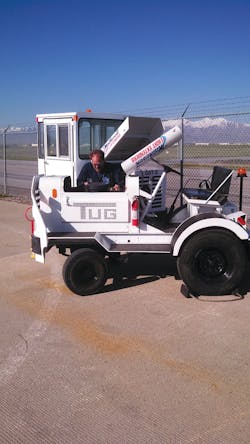With the seasons turning to hotter weather, GSE techs need to focus on what receives the most punishment as temperatures and humidity rise over the summer.
Here are a several key maintenance procedures to keep GSE in service between now and autumn. The dog days of summer really put GSE to test in two ways. First, the equipment naturally runs hot and only gets hotter by August. Second, the same applies to the operators who get just as hot and sometimes may not follow the proper procedures while operating the equipment:
Cooling Systems
There are several components in our equipment’s cooling systems that should be inspected closely:
- Of course, the coolant level should be kept full, but the mixture should be correct as well.
- The circulation of the coolant should be checked as well. The thermostat should open at or near the proper temperature level. The radiator fan should have the blades checked for cracks, missing blades, and straightness. The fan belts should be tight and free of weather cracking.
- If the unit is equipped with a fan clutch, it should be checked to ensure that it spins with some resistance and does not freewheel. If the unit utilizes an electric fan, make sure that it engages at the proper temperature.
- Engine oil level and cleanliness is important as well. Engine oil not only lubricates and cleans engine internals, but it cools components too.
- Starting with the radiator, the cap should seal properly and be made for the pressure required for your system. As far as the radiator goes, the fins should be straight and as clean as possible. Check through the filler hole for corrosion and build up. If any is present, then the radiator should be flushed with a good quality radiator flush.
- The cooling system should also be tested with a pressure tester to help locate any leaks. Check all radiator and heater hoses for cracks, blistering, and swelling. All clamps should be checked for tightness too.
- If the machine is equipped with an overflow reservoir, make sure that the return hose is free of leaks and the tank is filled to the proper level.
- The water pump should be checked for leaks around the weep hole. If any coolant or coolant staining is evident, it is a sign that the shaft seals are going bad. It is a good idea to replace it now instead of waiting until it goes out completely.
Transmissions
Summer heat is especially hard on these components, so here are a few things we can do before the heat really sets in:
- First, the transmission should be fully serviced. This includes replacing the fluid, filter and pan gasket.
- Check the cooler lines for leaks, blisters, and cracks. Make sure all clamps and fittings are tight.
- If the transmission is equipped with an external modulator, remove and check the condition of the vacuum hose. If the vacuum spigot is wet with ATF, then the modulator is bad and should be replaced.
- While you are down there, it’s a good time to check the driveshaft and u-joints for tightness and play.
Hydraulic Oil Coolers
Although these do not usually require much maintenance, they should still be checked to make sure that the fins are straight and free of debris. Check the condition of the supply and return hoses, too.
Tires
Now here’s an item that gets plenty of punishment during hot weather. With ramp temperatures soaring above 150 degrees in some locations, you can literally watch as the tires are ground into black powder. The heavier the equipment and the tighter it turns, the tougher it is on tires.
There are, however, a couple of things we can do to help prolong tire life:
- Whether the machine uses pneumatic or solid tires, proper alignment is crucial. Camber, caster, and toe in settings must be correct for the tires to wear evenly.
- Proper rotation is important as well. If the unit uses the same tire and wheel combo front to rear, then the tires should be rotated at every PMI interval.
- Tire pressure should be monitored too. Nothing will wear out a set of tires faster than running them at too low of a pressure - especially during the summer months. The operators have to look for cuts in tires and also watch their driving speed.
Batteries
The hot season is worse on batteries than any other time of the year. There are some preventive steps we can take to help them last as long as possible:
- If the battery is not a sealed maintenance-free type, then the electrolyte level should be checked frequently to ensure it is full. At this time it should also be checked with an electrolyte gauge. If one cell reads low, then the cell is going bad. You might as well replace the battery because it doesn’t have much time left.
- The battery connections and terminals should be clean and tight at all times to ensure you have full cranking amperage to the starter when required. This also ensures that the battery gets charged fully by the alternator.
Charging System
The alternator should be checked with a multimeter to ensure that it is charging properly and keeping the battery voltage topped off. Also check the alternator belts for proper adjustment and condition.
Brake Systems
The equipment’s brake system takes an extra beating during the summer months as well:
- Brake pads and shoes should be checked more frequently when operating in higher temperatures.
- Brake hoses should also be checked for dry rot, swelling, and leaks.
- If the brake fluid in the reservoir is very murky, then the system should be drained and flushed.
Each season presents challenges our maintenance staff must constantly meet - whether it's summer's heat or winter's cold.
By being proactive, however, we can cover our bases and keep equipment downtime to a minimum when the weather heats up. The equipment has to be monitored very closely and the pre- trip and post- trip paperwork has to be filled out correctly so that GSE staff can catch any mechanical issues before bigger problems happen.
About the authors: Kenneth DeVolpi, manager of sales and marketing and special projects manager, has worked for Matheson for more than three years and has been in the aviation industry for more than 20 years, including 15 years with Northwest Airlines. Jason Chapman works in the company's GSE maintenance department and gained GSE mechanical experience with the U.S. Air Force and has worked in the commercial GSE industry for 12 years.




